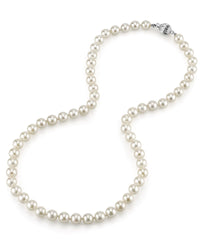
Japanese Akoya White Pearl Necklace, 6.5-7.0mm - AAA Quality
$1,540.00 Sale: $1,232.00

Pearls are one of the oldest gems known to man and have been worn as jeweled adornments since antiquity. Yet they also have a mystique about them which makes them even more alluring. Pearls are seeing a modern renaissance. From fashion runways to political elite, pearls are the go-to jeweled accessory favored by many. The truth, though, is that today as in the past, our love affair with pearls is seemingly and happily unending.
Pearl necklaces are the perfect piece to start your pearl jewelry collection. Choosing your first pearl necklace can be exciting and overwhelming in equal parts. But it doesn’t have to be so. With a little research and some reflection, you can find the perfect pearl necklace for yourself. Here are a few points to consider.
As far as cultured pearls go, there are four main types of pearls you can look for in a necklace.
Akoya Pearls were the first pearls to be cultured at pearl farms and are of salt water origin. Renowned for their incredibly sharp, mirror-like luster, they are available in sizes ranging from 3mm up to more than 10mm. Akoya pearls come in a variety of natural colors. White with rose, cream and silvery overtones is the most beloved Akoya pearl color, but these pearls can also be found in shimmering blue as well as captivating golden hues. Black Akoya pearls are color treated but this does not take away from either their beauty or their value. For anyone on the lookout for a “classic” pearl necklace, Akoya pearls are what you should go for.

Akoya Pearls with Rose Overtones
A special type of Akoya pearls are the Hanadama pearls. These are top quality Akoya pearls that have been certified by the Pearl Science Laboratory in Japan, an internationally recognised organisation dedicated to pearl research, quality analysis and pearl certification. What sets Hanadama pearls apart from other Akoya pearls is that they comprise the top 3% of Akoya pearls and meet the highest quality criteria for these pearls. Hanadama pearls are prized for their incomparable luster and their spectacular “aurora” iridescence. Dazzling, to say the least, a Hanadama pearl necklace could easily be the apogee of any pearl lover’s jewelry collection.

White Freshwater Pearls
Freshwater Pearls are another great option. Famous for their beautiful, natural, pastel colors including white, pink, peach and lavender, as well as for their bewitching overtones, Freshwater pearls give jewelry lovers many different options to choose from. Freshwater pearl cultivation started over half a century ago and today you can find gem quality freshwater pearls that boast a striking luster and perfect skins. Nevertheless, even top quality Freshwater pearls are not as expensive as their Akoya cousins. This makes them perfect for a first time necklace buyer who initially just wants to dip their toes in these pearlescent waters.
Tahitian Pearls, another saltwater cultured pearl variety, are sometimes referred to as “black pearls” but that’s a grossly misleading description. Ranging in body colors from light to charcoal grey and all the way to black, and showcasing beguiling overtones that embrace a myriad of tones such as blue, green, silver, aubergine, rose, gold, peacock and cherry, Tahitian pearls are luxury, statement gems. Cultured in the picturesque waters of French Polynesia, Tahitian pearls are valued for their thick nacre, satiny luster and the vast array of shapes they come in. For anyone wanting to turn heads, you cannot go wrong with a Tahitian pearl necklace.

Deep Gold South Sea Pearls
South Sea Pearls are often dubbed the queen of cultured pearls and they undoubtedly deserve this moniker. Their colors range from irresistible silvery and satiny white to several seductive tones of gold - light, champagne, medium and deep. South Sea pearls, just like Tahitians, have a satiny luster which appears luminous, such that the pearl seems to shine from within. Of all the different types of cultured pearls, it is the South Sea oysters that produce the largest pearls, sometimes even as big as 20mm or more. Rare and lovely, a well-matched, graduated, lustrous South Sea pearl necklace is the ultimate pearl jewel!
While there is no standard, internationally accepted pearl grading system, the value of pearls is easily established by referring to several different factors which include the following:

Round, lustrous White South Sea Pearls
Single strand pearl necklaces are available in several different lengths. Choosing the best length is a happy medium between which length appeals to you and what looks good on you.

Finally, when you have done your research and made your decision about the pearl necklace you would like to add to your jewelry collection, there are still a few things to keep in mind.
Wearing pearls is, undoubtedly, akin to making a style statement. Therefore, a lovely pearl necklace should not be looked upon as just a jeweled adornment. It is, in fact, an investment that will give you years and years of joy.
Featured Image: Golden South Sea Pearl Necklace, Pearls of Joy
Reema Farooqui is a content writer who loves pearls and pearl jewellery. You can find her on her website The Culture of Pearls or on Instagram at @thecultureofpearls